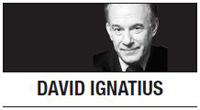
The showy first summit between US President Donald Trump and North Korean leader Kim Jong-un last June was draped in flags and bunting, but the decoration covered what turned out to be a mostly empty box that lacked a shared agreement on denuclearization.
Given this disappointing record, what’s realistically possible when the two leaders meet again in two weeks in Vietnam?
“Diplomacy is letting someone else have your way,” as the late Canadian Prime Minister Lester Pearson once observed. But that adage applies to Kim as much as Trump. The best outcome may simply be a road map that, by opening pathways and marking obstructions, makes both sides safer during a decadelong process toward the US goal of “final, fully verified denuclearization.”
In the run-up to the Hanoi summit, some pragmatic ideas are being floated by experts in and out of the Trump administration. The premise of these discussions is that denuclearization won’t be a sudden stand-down but a phased process that, if it’s successful, will create its own momentum and ever-increasing security.
The baseline for US officials is a recognition that, as Director of National Intelligence Dan Coats put it in congressional testimony last month, “North Korea is unlikely to give up all of its nuclear weapons and production capabilities, even as it seeks to negotiate partial denuclearization steps to obtain key US and international concessions.”
Trump tried to put the best face on this stark assessment afterward, tweeting, “North Korea relationship is best it has ever been with US. No testing, getting remains, hostages returned. Decent chance of Denuclearization.” All true, except for the last bit, which remains fuzzy, at best.
Stephen Biegun, Trump’s special envoy for North Korea, offered a frank account in a Jan. 31 speech at Stanford University. “North Korea has given us little indication that they have yet made the decision to completely dismantle and destroy that (nuclear) capability. We all know that.” The challenge, he said, is to “change the trajectory of their policies by changing the trajectory of our own.”
Biegun has been collecting ideas from experts from Stanford and the Carnegie Endowment for International Peace. It’s not clear what, if anything, has emerged from these conversations, but papers prepared by the two groups illustrate some of the background issues for the Hanoi meeting.
The Carnegie group, led by George Perkovich, Ariel Levite and Toby Dalton, has focused on the importance of comprehensive, verifiable caps on North Korea’s nuclear arsenal, during the long process toward denuclearization. In gathering information for their recommendations, they‘ve held meetings with Chinese and other international experts.
The Carnegie team has explored how limits on North Korea’s nuclear and missile program might be verified, given the lack of modern infrastructure in that country and its poor record-keeping. The answer, they argue, is “probabilistic verification,” which may not measure every item in the stockpile but can give a reliable overall assessment of whether Pyongyang is complying.
The Stanford team, headed by Siegfried Hecker, Robert Carlin and Elliot Serbin, stresses specific, observable measures of whether the North Korean threat is receding. They argue that “2018 (marked) a halt and some rollback,” after Kim stopped nuclear and missile testing and closed a nuclear test site. And they provide benchmarks to assess whether future diplomacy is sustaining this progress.
“North Korea will not give up its weapons and its weapons program until its security can be assured,” argue the Stanford experts. “Such assurance cannot be achieved simply by an American promise or an agreement on paper, it will require a substantial period of co-existence and interdependence ... that may stretch to 10 years.”
The Stanford team argues that as a sweetener -- and also to employ North Korean scientists and boost verification -- Pyongyang should be allowed to retain a civilian nuclear program and a peaceful space program.
Trump will undoubtedly crank up the hype machine at the Hanoi summit, so experts should analyze carefully the details of whatever agreement emerges -- and on whether that accord continues the reduction of the North Korean military threat that began last year.
The bedrock of this diplomatic opening is so basic that people often overlook it. But read carefully what Biegun said at Stanford, “President Trump is ready to end this war. It is over. It is done. We are not going to invade North Korea. We are not seeking to topple the North Korean regime. ... We are ready for a different future. It’s bigger than denuclearization, while it stands on the foundation of denuclearization.”
Trump’s summitry with Kim is partly hot air. But there’s something real and fundamental here, too, which could make the world safer.
By David Ignatius
David Ignatius can be reached via Twitter: @IgnatiusPost. -- Ed.
(Washington Post Writers Group)








